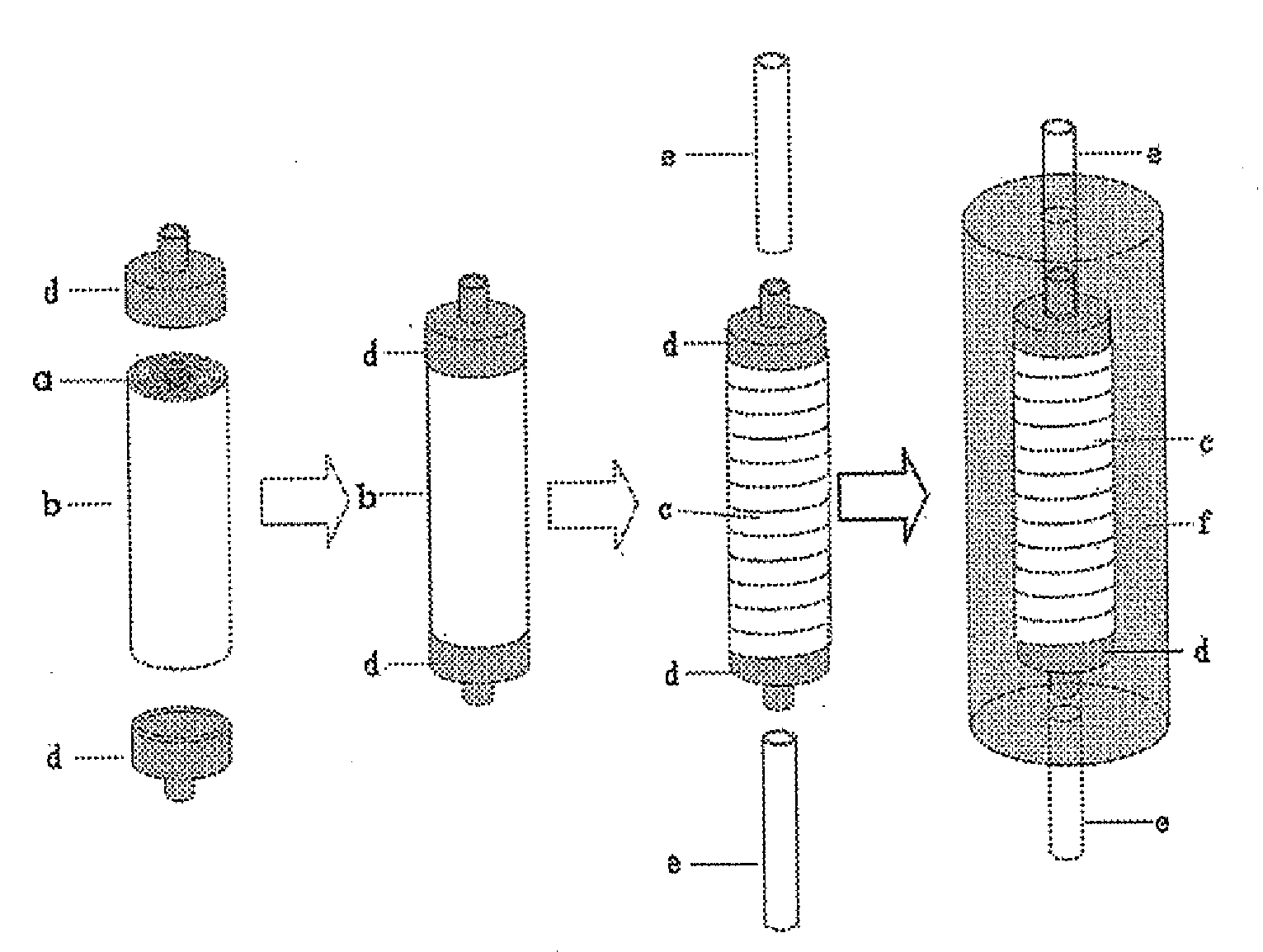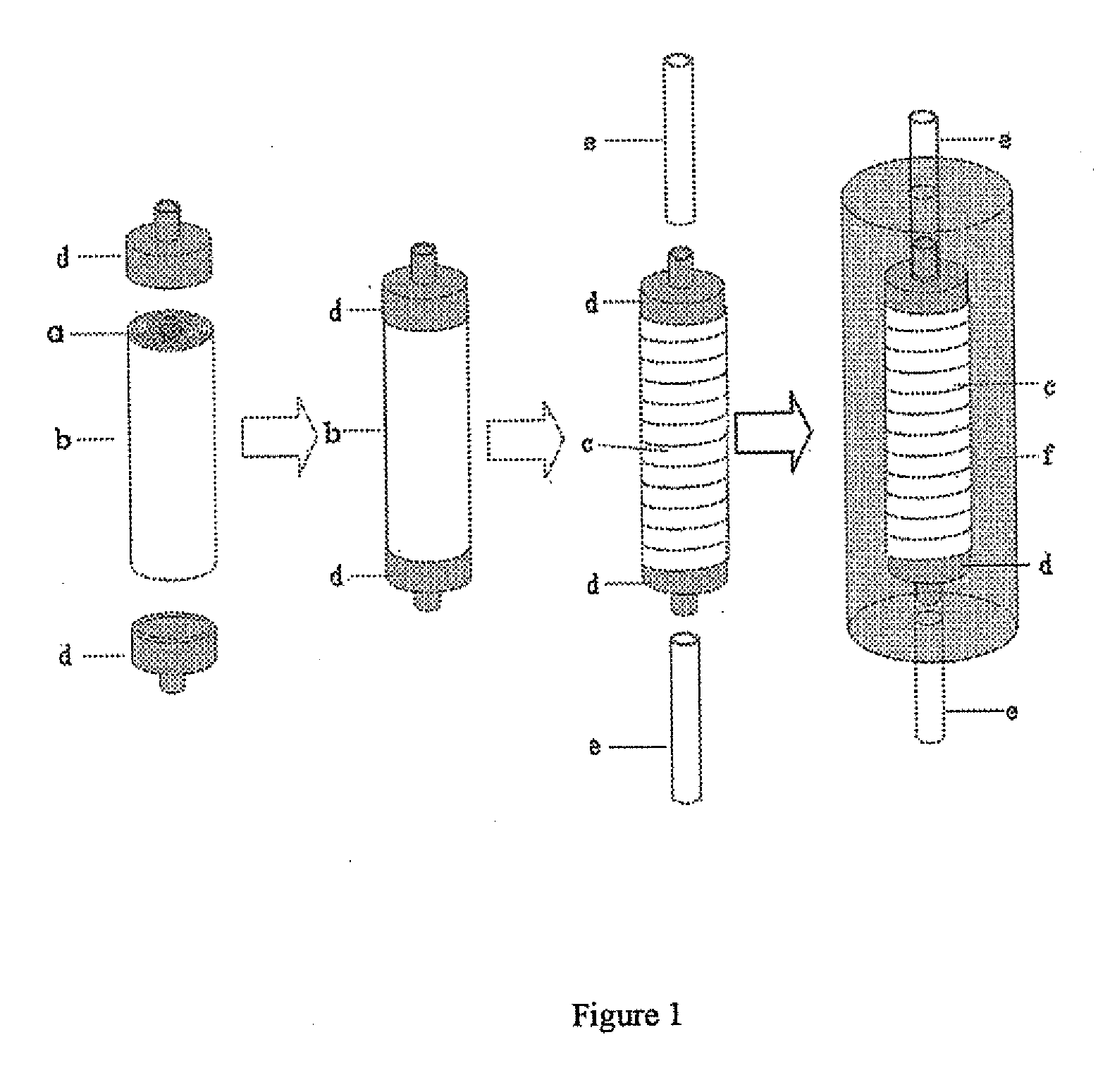Carriers for Enzyme or Cell Immobilization and Immobilization Method Using the Carriers
a technology of enzymes or cells and carriers, applied in the field of enzyme/cell immobilization technology, can solve the problems of large restrictions on the specific surface area of present technology, carriers are easily cracked, etc., and achieve the effect of large specific surface area and less fragil
- Summary
- Abstract
- Description
- Claims
- Application Information
AI Technical Summary
Benefits of technology
Problems solved by technology
Method used
Image
Examples
example 1
The Water Natural Wetting Rate of the Organic Porous Material
[0022]The dried organic porous material was cut into cubes of 5 cm in length, and when the material was placed gently on the surface of distilled water of 20 cm in depth, the timing was started at once. The test was terminated 10 minutes after the timing was started or when the material was completely wetted. Under this condition, the water natural wetting rate of the material was defined as the ratio of the height (in mm) vertical to the water surface of the wetted portion (including the portion immersed in water) of the organic porous material to the time (in second) taken to wet the portion of the material. A number of organic porous materials had been tested and the results were shown in Table 1.
TABLE 1Whetherbeing Able toSpecificWettingImmobilizeDensityRateCells EvenlyProduct designationmodelSource(g / cm3)(mm / second)or notPolyester FoamST33Shenzhen Lian Da Industry Co Ltd0.0501NoPolyurethane FoamDL68Shenzhen Lian Da In...
example 2
Immobilization of E. coli Cells Containing Expressed Glucose Isomerase on Granular Carriers (I)
[0023]Based on the sequence of pGEMT-Easy (Promega), the following primers RBS-NdeI and RBS-AlwNI for PCR were designed:
Forward primer RBS-NdeI:5′-CATATGTATATCTCCTTCTTGTGTGAAATTG-3′Reverse primer RBS-AlwNI:5′-CAGTGGCTGCTGCCAGTGGCGATAAGTC-3′
[0024]a DNA fragment of 755 bp was obtained by PCR amplification using pGEMT-Easy (Promega) as template, and the RBS-NdeI and RBS-AlwNI as primers. The PCR amplification condition was: 50 ng pGEMT-Easy (Promega), 0.4 μM RBS-NdeI, 0.4 μM RBS-AlwNI, 50 μM dATP, 50 μM dTTP, 50 μM dCTP, 50 μM dGTP, 20 mM Tris-HCl (pH 8.8), 10 mM KCl, 10 mM (NH4)2SO4, 2 mM MgSO4, 0.1% Triton X-100, 2.5 U Pfu DNA Polymerase (Promega), and the volume was adjusted to 50 μl with sterile distilled water. PCR amplification program for the reaction was: 94° C., 5 minutes; then 35 cycles of 94° C., 1 minute; 50° C., 1 minute; 72° C., 4 minutes; and 72° C., 10 minutes. The PCR product...
example 3
Immobilization of E. coli Cells Containing Expressed Glucose Isomerase on Granular Carriers (II)
[0029]40 ml cell suspension prepared as described in Example 2 was mixed with 6 ml of 0.25 mM CoCl2 to uniformity. Pulp foam (3M Hong Kong Ltd) was washed thoroughly to remove any surfactants, cut into particles of roughly 15 mm3 in size and dried up. 4 grams of dried foam cubes were placed into a nylon mesh bag, which was then placed inside a plastic bag, and added with the 46 ml cell suspension containing CoCl2. The mixture was pressed by hand for at least 3 minutes to make the components mixed so as to ensure even distribution of the liquid in the foams, into which 10 ml of 2.5% PEI solution (pH 7.0) was added, pressed by hand again repeatedly for at least 3 minutes to make the components mixed; 10 ml of 2.5% glutaraldehyde solution was added and the mixture was pressed by hand repeatedly for at least 5 minutes to make the components mixed. The nylon mesh bag was then taken out from th...
PUM
| Property | Measurement | Unit |
|---|---|---|
| Speed | aaaaa | aaaaa |
| Time | aaaaa | aaaaa |
| Time | aaaaa | aaaaa |
Abstract
Description
Claims
Application Information
 Login to View More
Login to View More - R&D
- Intellectual Property
- Life Sciences
- Materials
- Tech Scout
- Unparalleled Data Quality
- Higher Quality Content
- 60% Fewer Hallucinations
Browse by: Latest US Patents, China's latest patents, Technical Efficacy Thesaurus, Application Domain, Technology Topic, Popular Technical Reports.
© 2025 PatSnap. All rights reserved.Legal|Privacy policy|Modern Slavery Act Transparency Statement|Sitemap|About US| Contact US: help@patsnap.com


